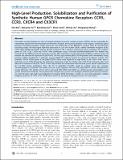High-Level Production, Solubilization and Purification of Synthetic Human GPCR Chemokine Receptors CCR5, CCR3, CXCR4 and CX3CR1
Author(s)
Xu, Zhinan; Cook, Brian L.; Ge, Baosheng; Yu, Daoyong; Ren, Hui; Zhang, Shuguang; ... Show more Show less
DownloadRen-2009-High-level productio.pdf (1.822Mb)
PUBLISHER_CC
Publisher with Creative Commons License
Creative Commons Attribution
Terms of use
Metadata
Show full item recordAbstract
Chemokine receptors belong to a class of integral membrane G-protein coupled receptors (GPCRs) and are responsible for transmitting signals from the extracellular environment. However, the structural changes in the receptor, connecting ligand binding to G-protein activation, remain elusive for most GPCRs due to the difficulty to produce them for structural and functional studies. We here report high-level production in E.coli of 4 human GPCRs, namely chemokine receptors (hCRs) CCR5, CCR3, CXCR4 and CX3CR1 that are directly involved in HIV-1 infection, asthma and cancer metastasis. The synthetic genes of CCR5, CCR3, CXCR4 and CX3CR1 were synthesized using a two-step assembly/amplification PCR method and inserted into two different kinds of expression systems. After systematic screening of growth conditions and host strains, TB medium was selected for expression of pEXP-hCRs. The low copy number pBAD-DEST49 plasmid, with a moderately strong promoter tightly regulated by L-arabinose, proved helpful for reducing toxicity of expressed membrane proteins. The synthetic Trx-hCR fusion genes in the pBAD-DEST49 vector were expressed at high levels in the Top10 strain. After a systematic screen of 96 detergents, the zwitterionic detergents of the Fos-choline series (FC9-FC16) emerged as the most effective for isolation of the hCRs. The FC14 was selected both for solubilization from bacterial lysates and for stabilization of the Trx-hCRs during purification. Thus, the FC-14 solubilized Trx-hCRs could be purified using size exclusion chromatography as monomers and dimers with the correct apparent MW and their alpha-helical content determined by circular dichroism. The identity of two of the expressed hCRs (CCR3 and CCR5) was confirmed using immunoblots using specific monoclonal antibodies. After optimization of expression systems and detergent-mediated purification procedures, we achieved large-scale, high-level production of 4 human GPCR chemokine receptor in a two-step purification, yielding milligram quantities of CCR5, CCR3, CXCR4 and CX3CR1 for biochemical, biophysical and structural analysis.
Date issued
2009-02Department
Massachusetts Institute of Technology. Center for Biomedical EngineeringJournal
PLoS ONE
Publisher
Public Library of Science
Citation
Ren, Hui et al. “High-Level Production, Solubilization and Purification of Synthetic Human GPCR Chemokine Receptors CCR5, CCR3, CXCR4 and CX3CR1.” PLoS ONE 4.2 (2009): e4509.
Version: Final published version
ISSN
1932-6203